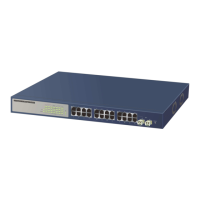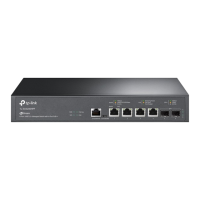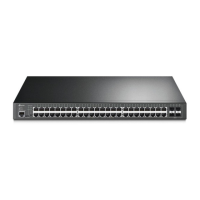Figure 32: Authentication Mapping Page
The Authentication Mapping Page contains the following
elds:
Console — Indicates that authentication profiles are
used to authenticate console users.
Telnet — Indicates that authentication proles are used
to authenticate Telnet users.
Secure Telnet (SSH) — Indicates that authentication
profiles are used to authenticate Secure Shell (SSH)
users. SSH provides clients secure and encrypted
remote connections to a device.
Secure HTTP — Indicates that authentication methods
are used for Secure HTTP access. Possible eld values are:
– None — Indicates that no authentication method is used for access.
– Local — Indicates that authentication occurs locally.
– RADIUS — Indicates that authentication occurs at the RADIUS server.
– Line — Indicates that authentication uses a line password.
– Enable — Indicates that authentication uses an Enable password.
– Local, RADIUS — Indicates that authentication first occurs locally. If authentication cannot be verified locally, the
RADIUS server authenticates the management method. If the RADIUS server cannot authenticate the management
method, the session is blocked.
– RADIUS, Local — Indicates that authentication rst occurs at the RADIUS server. If authentication cannot be veried
at the RADIUS server, the session is authenticated locally. If the session cannot be authenticated locally, the session is
blocked.
– Local, RADIUS, None — Indicates that authentication rst occurs locally. If authentication cannot be veried locally, the
RADIUS server authenticates the management method. If the RADIUS server cannot authenticate the management
method, the session is permitted.
– RADIUS, Local, None — Indicates that authentication rst occurs at the RADIUS server. If authentication cannot be
veried at the RADIUS server, the session is authenticated locally. If the session cannot be authenticated locally, the
session is permitted.
HTTP — Indicates that authentication methods are used for HTTP access. Possible eld values are:
– None — Indicates that no authentication method is used for access.
– Local — Indicates that authentication occurs locally.
– RADIUS — Indicates that authentication occurs at the RADIUS server.
– Line — Indicates that authentication uses a line password.
– Enable — Indicates that authentication uses an Enable password.
– Local, RADIUS — Indicates that authentication first occurs locally. If authentication cannot be verified locally, the
RADIUS server authenticates the management method. If the RADIUS server cannot authenticate the management
method, the session is blocked.
– RADIUS, Local — Indicates that authentication rst occurs at the RADIUS server. If authentication cannot be veried
at the RADIUS server, the session is authenticated locally. If the session cannot be authenticated locally, the session is
blocked.
– Local, RADIUS, None — Indicates that authentication rst occurs locally. If authentication cannot be veried locally, the
RADIUS server authenticates the management method. If the RADIUS server cannot authenticate the management
method, the session is permitted.
– RADIUS, Local, None — Indicates that authentication rst occurs at the RADIUS server. If authentication cannot be
veried at the RADIUS server, the session is authenticated locally. If the session cannot be authenticated locally, the

